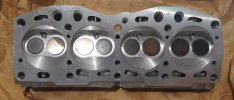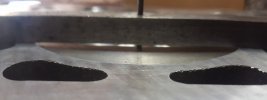other factors that will contaminate the data with that approach? Not sure if dynamic compression vs static plays into this any (don't think so).
It sure does, in fact a cranking compression test is more a measure of the engines dynamic CR than it is even close to being a measure of the engines static CR. A long duration or long overlap cam will seriously alter cranling compression values by large amounts... even small variance in settings like the lash adjustment (which alters the valve timing effectively) will give a variance in readings across an engine..let alone variance in equipment/method.
I'd have guessed that someone on Xweb has actually measured/calculated the stock compression ratio of the engine after all these years of doing so much to them.

Especially all the X1/9 racers out there.
we racers are not so much worried about what the static CR was, but far more interested in what we can achieve (i.e. higher static CR) with parts mixing and matching...
If anyone does have a number, it will only ever be a "nominal" figure anyway...each head will be slightly different and half a cc makes a difference...so the ONLY true way to ever know the ACTUAL static CR is by direct measurement of the particular engine involved... no other way, that's it.
The figure of 33.5 +-0.5cc for a Flat faced euro style head is quite constant... we know that some US spec heads are actually the same casting number as a head we get here in Australia (so same casting number in both flat and full circular decompression recess style heads) we know the recess is approx 1.5mm deep from the head face when the head is new, we also know the cut isn't flat on the bottom...it's is a section of a sphere (as can be seen by the remnants of these in JimD's pic of the MWB head) which I have never been able to accurately determine it's depth...
so a 1.5mm deep recess is approx 7.5cc, but we cant just add this to the 33.5 number...as the two sections intersect and share common volume. a good guess would be approx 4 to 5 cc is added by the full circular decompression recess in the US spec heads.
And then add to my calculation (which was sort of assuming the piston crown sat at zero deck when at TDC) the distance down the bore the stock piston sits...I have only been able to measure australian spec engines, and these sit shy of the stock deck by approx 0.35mm...the pistons measure with a CH of 34.65mm (zero deck on a stock block is generally about 35.0mm)
Now according to Fiat parts literature the USA spec piston crown are actually a CH of 34.45.... which goes with anecdotal evidence I have read / heard that the USA spec engines have the pistons sitting 0.5mm / 20 thou below the deck...which sounds about right with a piston of 34.5ishmm of CH.
anyway add in the volume the piston is shy of zero deck, ring land clearance etc and your going to be up around that 53cc of total volume above the piston at TDC... so I stand by my "educated guesstimate" of 8.1:1 being far more accurate than 8.5:1 ever was .... but if all the clearances stacked up (i.e valves less recessed in seats, combustion chamber cuts at minimum, deck cut at maximum tolerance (low) ...i.e. all the things that could possibly make the volume smaller, so the very smallest volume possible with a combination of all variables...then you might have 8.5:1 as an absolute maximum.
SteveC


